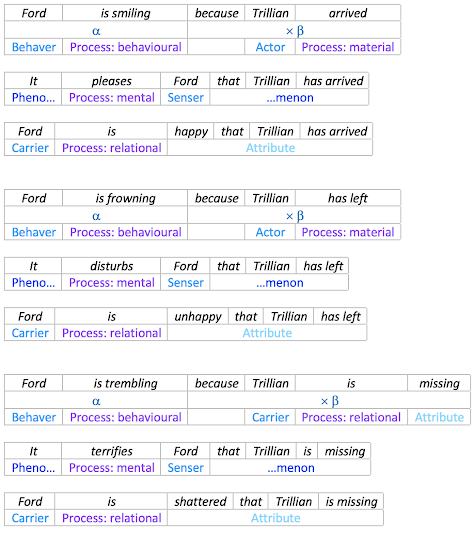Martin (1992: 16):
First, there is the question of semantic motifs running through the grammar which cannot be generalised at that level because of their diverse structural realisations. The following proportionalities can be used to illustrate this point:
Following Halliday (1985), the first clause in each set is behavioural, the second mental and the third relational — fundamentally different process types. At the same time, all three clauses construct a relatively uniform, and not unfamiliar disposition for Ford. One way to generalise across these various realisations of the same disposition is to stratify the content plane, setting up an attitude network realised across process types (with realisations extending into other areas of the grammar as well; for example, adverbial and nominal groups).
Blogger Comments:
To be clear, these 'semantic motifs' are the first of Martin's three reasons for his innovation of stratifying the content plane, despite the fact that the content plane is already stratified into semantics (meaning) and lexicogrammar (wording) in SFL Theory. Cf Halliday (1985: xvii-iii):
[1] To be clear, in SFL Theory, generalisation is a matter of systemic delicacy, not stratification. The relation between strata is one symbolic abstraction.
[2] To be clear, it is not true that different structural realisations necessarily warrant systems on a higher stratum. This is because the system of a stratum is already of a higher level of symbolic abstraction than the structures it specifies.
[3] To be clear, the proportionality here is somewhat reduced, not least because, unknown to Martin, the first instance in each set is a clause complex, not a clause.
[4] To be clear, the "relatively uniform, and not unfamiliar disposition for Ford" in each set is variously construed as:
- a behavioural Process manifesting a conscious state,
- a mental Process impinged upon by a Phenomenon, and
- an Attribute realised by a qualified Epithet.
The rhetorical device deployed here is unnecessary complication — in order to overload the reader. Martin could easily have just contrasted:
- Ford is smiling [behavioural]
- Ford is rejoicing [mental]
- Ford is happy [relational]
[5] To be clear, having presented this as a reason for stratifying the content plane, Martin does not set up the proposed attitude network, and the issues are not raised again in the entire book.



No comments:
Post a Comment